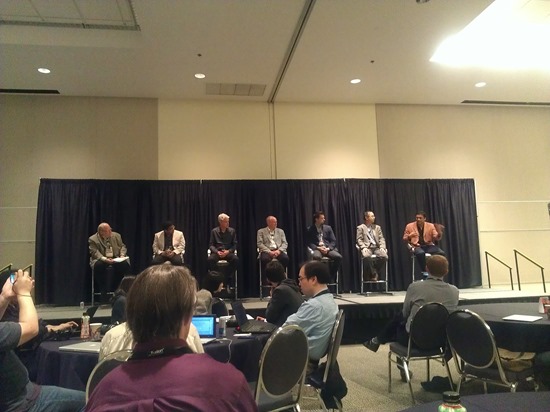AMD, ARM and Texas Instruments join forces to create a unified heterogeneous computing platform

On June 12, a new open initiative Heterogeneous System Architecture (HSA) Foundation , which included AMD, ARM, Texas Instruments, MediaTek and Imagination, was presented at the plenary report at the AMD Fusion'12 Developer Summit conference. This non-profit open organization is based to create a single, open industrial architecture for heterogeneous computing (CPU + GPU), heterogeneous processors that will combine two or more different types of processors in a single chip.
At the moment I am at the conference itself, which takes place in Bellevue, USA and is ready to share with you some of the details of the announcement and first-hand data.
AMD Fusion'12 Developer Summit
A few words about the event, in which the announcement was made. This is a relatively new conference, which was first held in 2011. The conference brings together developers from around the world and offers to discuss the topic of heterogeneous computing, computing using GPU, industry standards in creating applications that use GPU and heterogeneous systems to solve complex computational problems. You can learn more about the conference from two of my reports from last visit in 2011:
')
- AMD Fusion 11 Developer Summit - as it was, Part 1
- AMD Fusion 11 Developer Summit - as it was, part 2 (details about the C ++ AMP platform)
In more detail about how the conference is being held this year, I will write later on when I return home.
Heterogeneous System Architecture Foundation

So, on June 12, AMD Fusion'12 plenary report met with representatives from AMD, ARM, Texas Instruments, MediaTek and Imagination in order to announce their new collaborative and open initiative for other companies along with the stage. I think that you know that AMD is putting a lot of effort into creating and promoting heterogeneous technologies, processors that combine CPU and GPU (they are called APU). For example, at the recent Computex exhibition, AMD introduced a new family of APU Series A, which won the prestigious exhibition award , as an outstanding product.

At the conference and later in the question and answer session, representatives of the founding companies of the HSA Foundation spoke about their plans. The companies will work together and invite other partners to their alliance in order to present a single architecture specification and simplify the software model in order to help software developers maximize the capabilities of modern processors and graphics cards. In addition, the new organization aims to find new solutions and technologies to increase the performance and energy efficiency of heterogeneous processors.
During the conference, some figures were announced, so in 2011, according to a study by IMS Research, about half of the revenue of the processor market was generated by hybrid and heterogeneous solutions. And that is why today today we need efficient tools that will help the developer to use all the computing power on the computer. At the same time, much was said that the existing solutions in the form of OpenCL are insufficient, since their use in application programs in high-level languages is difficult or impossible.
The HSA Foundation initiative is also designed to offer application development technologies for any language: native or managed. For example, one of the partner companies AMD has already created a solution that allows the use of the power of heterogeneous systems in Java. Another example is the open platform C ++ AMP, which allows C ++ developers to easily use all the computing power that is in the system (multi-core CPU, GPU, APU). HSA will use C ++ AMP, as well as OpenCL and other technologies in order to offer a single development platform. A little more information can be found on the official FAQ for developers .

At the press conference, the founders of the HSA Foundation called on not only companies to join the initiative, but also individual developers who can offer their own vision of what tools and solutions should be used to enable computers to utilize the computing power.
Anyone can find a lot of information on the following links:
- Official website of the HSA Foundation - www.hsafoundation.com
- Official Twitter: @HSAFoundation
- Posting on Facebook www.facebook.com/HSAFoundation
- Video from the plenary report with the story about the HSA Foundation ( here )
Source: https://habr.com/ru/post/145781/
All Articles